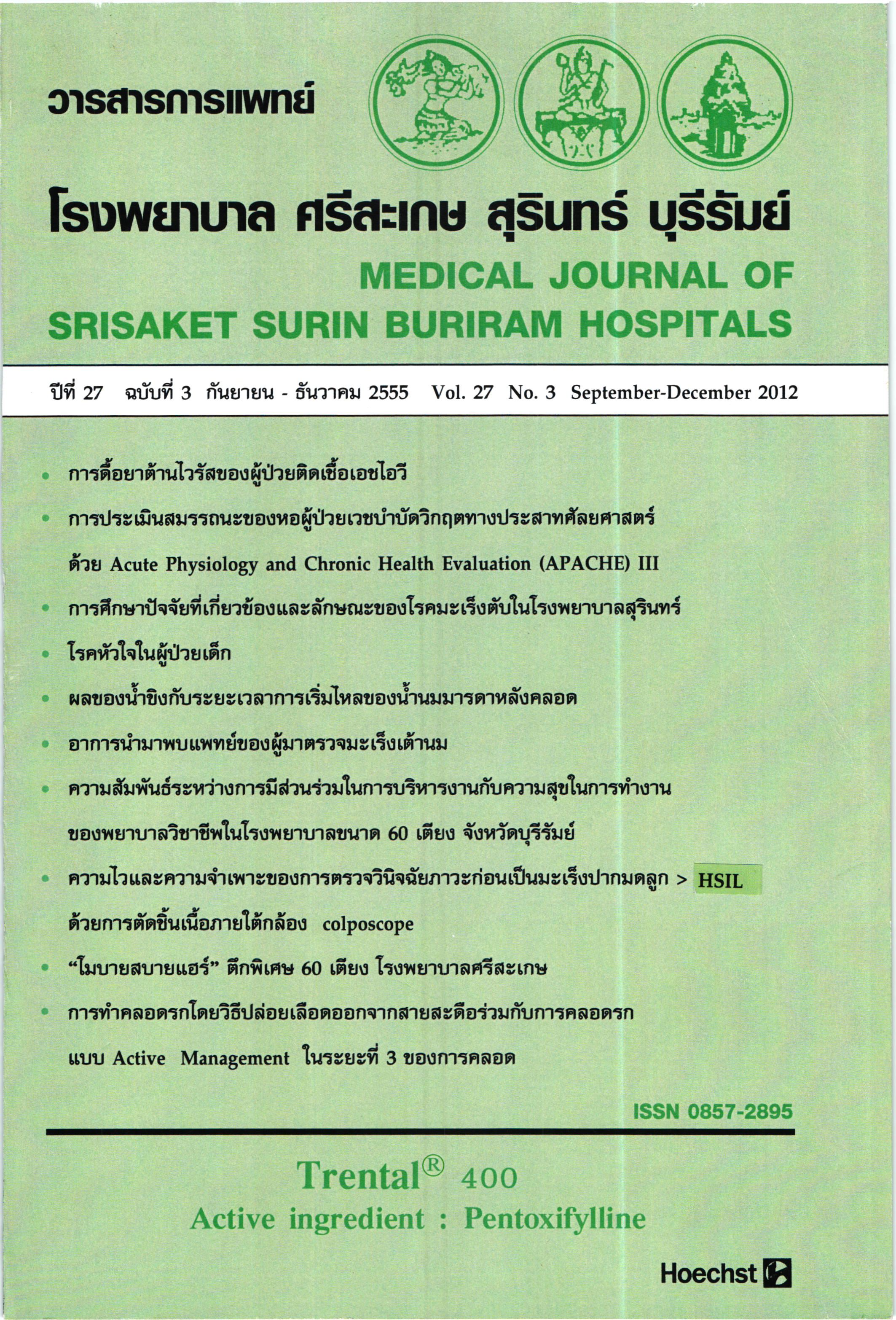การประเมินสมรรถนะของหอผู้ป่วยเวชบำบัดวิกฤตทางประสาทศัลยศาสตร์ ด้วย Acute Physiology and Chronic Health Evaluation (APACHE) III
Main Article Content
บทคัดย่อ
ความเป็นมา: ในประเทศไทย ยังไม่พบการศึกษาเกี่ยวกับการประเมินสมรรถนะทางการแพทย์ ของหอผู้ป่วยเวชบำบัดวิกฤตทางประสาทศัลยกรรม คณะผู้วิจัยจึงได้ทำการศึกษานี้ขึ้น เพื่อให้ทราบ ถึงระดับความรุนแรงของโรค ในผู้ป่วยวิกฤตทางประสาทศัลยศาสตร์ ที่ได้รับการรักษาในหอ อภิบาลผู้ป่วยวิกฤตในสถาบันประสาทวิทยา โดยการประเมินด้วย Acute Physiology and Chronic Health Evaluation (APACHE) III score รวมทั้งความสัมพันธ์ของค่าคะแนนกับ อัตราการเสีย ชีวิต และระยะเวลาวันนอน
วิธีการ: เป็นการศึกษาแบบ cross sectional โดยคัดเลือกผู้ป่วยใหม่ที่เข้ารับการรักษาในหอผู้ป่วย วิกฤตประสาทศัลยศาสตร์ทุกราย ทำการบันทึกข้อมูลทั่วไป และข้อมูลทีเกี่ยวข้องกับความ รุนแรงของโรค ตามกฎเกณฑ์ของ APACHE III ภายในเวลา 30 นาที หลังจากที่รับผู้ป่วยและเมื่อทำการรักษาผู้ป่วยเสร็จสินจึงทำการบันทึกระยะเวลานอนในหออภิบาล ระยะ เวลาวันนอนในโรงพยาบาล อัตราการเสียชีวิตเมื่อผู้ป่วยย้ายออก และอัตราการเสียชีวิตเมื่อ ผู้ป่วยกลับบ้าน
ผลการศึกษา: ผู้ป่วยทั้งหมดมีจำนวน 274 คน เข้ารับการรักษาแบบ elective 246 คน (89.8%) รับย้าย ผ็ป่วยมาจากห้องผ่าตัด 269 คน (98.2%) ได้รับการวินิจฉัยโรคว่าเป็น cerebral tumour 200 (73.0%) คน สาเหตุที่รับผู้ป่วยเข้ารักษาเนื่องจากเป็นการผ่าตัดใหญ่ 255 (93.1%) คน ระยะเวลาวันนอนในหออภิบาล 9.37±18.03 วัน ระยะเวลาวันนอนในโรงพยาบาล 22.71± 25.08 วัน ไม่มีผู้ป่วยเสียชีวิตเมื่อย้ายออกจากหออภิบาลผู้ป่วยหนัก และมีผู้ป่วยเสียชีวิต 12 (4.4%) คน เมื่อจำหน่ายออกจากโรงพยาบาล ค่าคะแนน APACHE III ในผู้ป่วยเฉลี่ยมีค่า เท่ากับ 29.78±16.87 (5-95) และเมื่อจำแนกตามชนิดของการผ่าตัด พบว่าไม่มีความแตก ต่างกันทางสถิติ
สรุปผล: ค่าเฉลี่ยคะแนน APACHE III ในผู้ป่วยวิกฤตทางประสาทศัลยศาสตร์ กับอัตราการเสียชีวิต เมือจำหน่ายออกจากโรงพยาบาล ระยะเวลาวันนอนในหออภิบาลผู้ป่วยหนัก และระยะ เวลาวันนอนในโรงพยาบาล พบว่าไม่มีความสัมพันธ์กันอย่างมีนัยสำคัญทางสถิติ
คำสำคัญ: ระยะเวลาวันนอน, อัตราการเสียชีวิต, สมรรถนะ, การพยากรณ์โรค ค่าคะแนน
Article Details
เอกสารอ้างอิง
2. Moran JL, Bristow P, Solomon PJ, George C, Hart GK. Mortality and length-of-stay outcomes, 1993-2003, in the binational Australian and New Zealand intensive care adult patient database. Crit Care Med 2008;36:1:46-61.
3. Wetzel RC, Sachedeva R, Rice TB. Are all ICUs the same? Paediatr Anaesth 2011;21:7:787-93.
4. Zimmerman JE, Wagner DP, Draper EA, Wright L, Alzola C, Knaus WA. Evaluation of acute physiology and chronic health evaluation III predictions of hospital mortality in an independent database. Crit Care Med 1998;26:8:1317-26.
5. Markgraf R, Deutschinoff G, Pientka L, Scholten T. Comparison of acute physiology and chronic health evaluations II and III and simplified acute physiology score II: a prospective cohort study evaluating these methods to predict outcome in a German interdisciplinary intensive care unit. Crit Care Med 2000;28:l:26-33.
6. Beck DH, Taylor BL, Millar B, Smith GB. Prediction of outcome from intensive care: a prospective cohort study comparing Acute Physiology and Chronic Health Evaluation II and III prognostic systems in a United Kingdom intensive care unit. Crit Care Med 1997;25:1:9-15.
7. Strieker KH, Sailer S, Uehlinger DE, Rothen HU, Zuercher Zenklusen RM, Frick S. Quality of life 9 years after an intensive care unit stay: a long-term outcome study. J Crit Care 2011;26:4:379-87.
8. Delibegovic S, Markovic D, Hodzic S. APACHE II scoring system is superior in the prediction of the outcome in critically ill patients with perforative peritonitis. Med Arh 2011;65:2:82-5.
9. Lim SY, Ham CR, Park SY, et al. Validation of the Simplified Acute Physiology Score 3 scoring system in a Korean intensive care unit Yonsei Med J 2011;52:l:59-64.
10. Glance LG, Osier TM, Dick A. Rating the quality of intensive care units: is it a function of the intensive care unit scoring system? Crit Care Med 2002;30:9:1976-82.
11. Knaus WA, Wagner DP, Draper EA, et al. The APACHE III prognostic system. Risk prediction of hospital mortality for critically ill hospitalized adults. Chest 1991;100:6:1619-36.
12. Zimmerman JE, Kramer AA, McNair DS, Malila FM, Shaffer VL. Intensive care unit length of stay: Benchmarking based on Acute Physiology and Chronic Health Evaluation (APACHE) IV. Crit Care Med 2006;34:10:2517-29.
13. Zimmerman JE, Kramer AA, McNair DS, Malila FM. Acute Physiology and Chronic Health Evaluation (APACHE) IV: hospital mortality assessment for today’s critically ill patients. Crit Care Med 2006;34:5: 1297-310.
14. Middle East Critical Care Assembly. APACHE® IV Calculator, [online]. 2009 [cite 2011 Oct 29]. Available from : http: //WWW. mecriticalcare.net/icu_scores/ apacheiv.php.)
15. Knaus WA, Draper EA, Wagner DP, Zimmerman JE. APACHE II: a severity of disease classification system. Crit Care Med 1985;13:10:818-29.
16. Becker RB, Zimmerman JE, Knaus WA, et al. The use of APACHE III to evaluate ICU length of stay, resource use, and mortality after coronary artery by-pass surgery. J Cardiovasc Surg (Torino) 1995;36:1:1-11.
17. Vasilevskis EE, Kuzniewicz MW, Cason BA, et al. Mortality probability model III and simplified acute physiology score II: assessing their value in predicting length of stay and comparison to APACHE IV. Chest 2009;136:1:89-101.
18. Gould A, Ho KM, Dobb G. Risk factors and outcomes of high-dependency patients requiring intensive care unit admission: a nested case-control study. Anaesth Intensive Care 2011;38:5:855-61.
19. Reed H. The development of an extended care facility in the recovery unit: the post-anaesthesia care unit. J Perioper Pract 2011;21:6:210-4.
20. Mirski MA, Chang CW, Cowan R. Impact of a neuroscience intensive care unit on neurosurgical patient outcomes and cost of care: evidence-based support for an intensivist-directed specialty ICU model of care. J Neurosurg Anesthesiol 2001;13:2:83-92.
21. Rubiano S, Gil F, Celis-Rodriguez E, Oliveros H, Carrasquilla G. Critical care in Colombia: Differences between teaching and nonteaching intensive care units. A prospective cohort observational study. J Crit Care 2011. 27:l:104.e9-104.el7
22. Ramesh VJ, Umamaheswara Rao GS, Kandavel T, Kumaraswamy SD, lyyamanda UB, Chandramouli BA. Predictive model for survival among neurosurgical intensive care patients. J Neurosurg Anesthesiol 2011;23:3:183-7.


